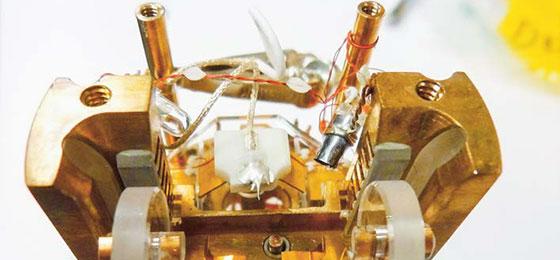Atomic data

Pioneering experiments to miniaturise data media are being conducted at EPFL and ETH Zurich. The latest research shows it is possible to save data on a single atom. By Olivier Dessibourg
(From "Horizons" no. 113 June 2017)
Wo At today's rate of data creation, existing systems will soon reach capacity. This is leading people to start questioning Moore's law, which says that the number of transistors that can be squeezed onto a given electronic chip doubles every 18 months. "The current path of miniaturisation" says Christopher Lutz, a physicist at IBM in Amalden, USA, "suggests that there would be, in principle, some 20 intermediate steps before arriving at the atom. This would require a further 30 to 40 years". Yet it appears we've arrived at this final step in a single stride, a landmark in what is a booming research field.
In 2016 teams led by Pietro Gambardella at ETH Zurich and by Harald Brune at EPFL showed that holmium atoms – a group of rare earth metals – could, on a certain surface, display a form of 'magnetic remanence'. On the basis that what can be magnetised can be used to store data, all that remained was to demonstrate the ability to read and write using the individual atoms. This is exactly what has been done by IBM's Lutz and Fabian Natterer, a member of Brune's team.
Writing on an atom
It's possible to write data to an atom, so long as it's possible to orient the atom's magnetisation in one direction or another, such as up or down. This is the same method used in hard disks, which record data encoded in binary bits (zeros and ones). "We used a scanning tunnelling microscope", says Natterer. This instrument has a minute tip which scans a material's surface, characterising each part of it with atomic precision. The tip is composed of an iridium atom and it emits a polarised electric current. This current is actually strong enough to change the magnetisation of holmium atoms and thereby to record a bit. "The effect is long-lasting", says Lutz.
Reading back the information can be done using one of two methods, Lutz adds. "The first also uses an electric current, which meets greater or lesser resistance depending on the magnetic state of the holmium atom, making it possible to distinguish the data recorded there". This is more or less what is done currently with hard disks, adds Natterer. "The second method is done remotely, by detecting the magnetic field of the holmium atom", says Lutz.
This is still currently a laboratory technique with very considerable restrictions. "It only works in a vacuum below 4 Kelvin (–269° C)", says Lutz. "The system is also very sensitive, because holmium atoms can move around on the surface", adds Gambardella. However, they are also looking into other ways of recording data on atomic matter.
Molecular data
Another approach is to magnetise molecules. "We are using a compound of dysprosium (Dy), which is another rare-earth element", says Florian Allouche, a chemist at ETH Zurich. "A priori, this molecule does not have a memory effect. Yet at low temperatures it can achieve magnetic remanence after having been grafted onto silica and treated chemically to create dysprosium ions (electrically charged atoms) which can later be applied to a surface". According to Allouche, there are both advantages and disadvantages to this technique. On the one hand, "the molecules are simple to prepare and to characterise and could be replicated on other surfaces", but on the other hand, "we have yet to find a way to define precisely the structure for the magnetic sites".
Where the scientists do agree is that current data storage won't be replaced by atomic data storage just yet. "But the proof of concept is there", states Lutz. And according to Natterer, "the discovery will allow us to study matter at the atomic level. And through the control of magnetism at that scale, we may even create exotic materials". Gambardella sees this research being applied to quantum computing. Lutz thinks that "our work is about doing as much good for the future as possible".
Olivier Dessibourg is a freelance science journalist based in Paris.
F. D. Natterer et al.: Reading and writing single-atom magnets. Nature (2017)F. Allouche et al.: Magnetic Memory from Site Isolated Dy(III) on Silica Materials. ACS Central Science (2017)